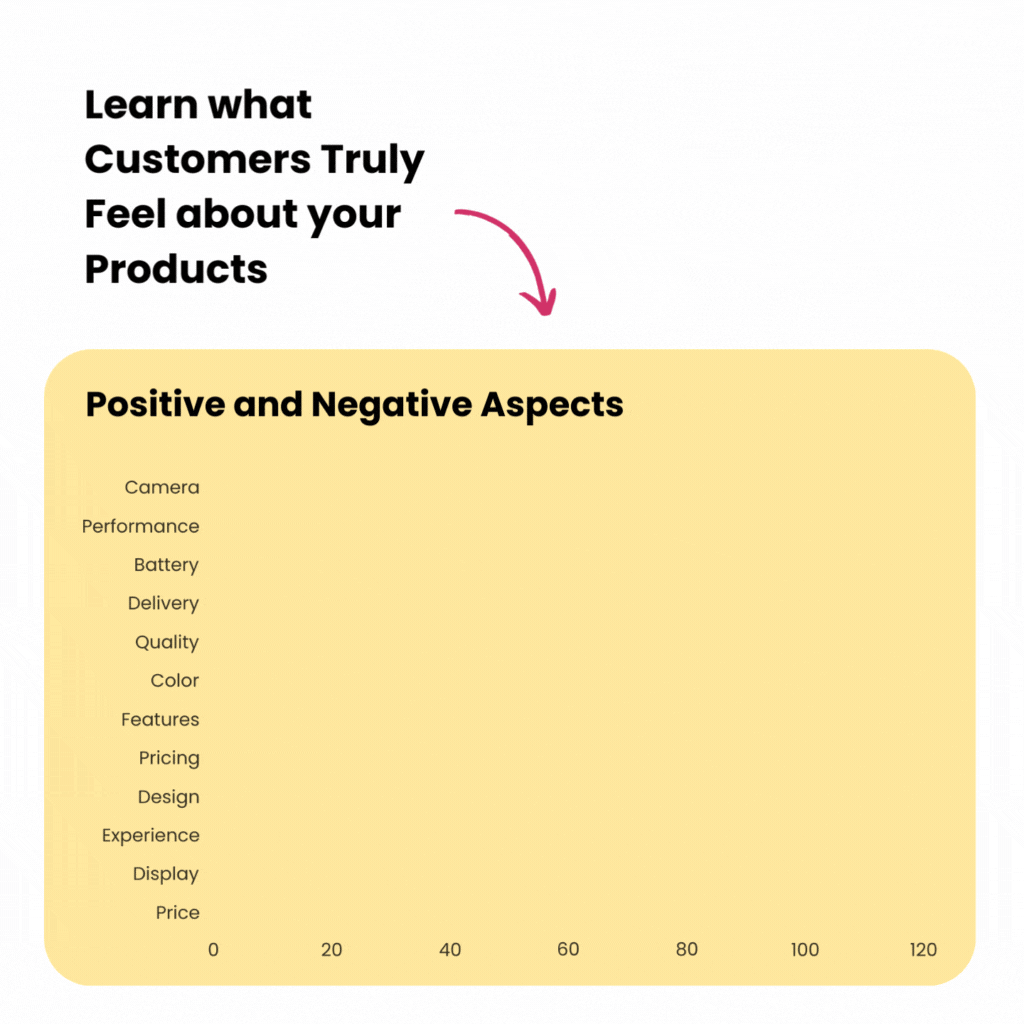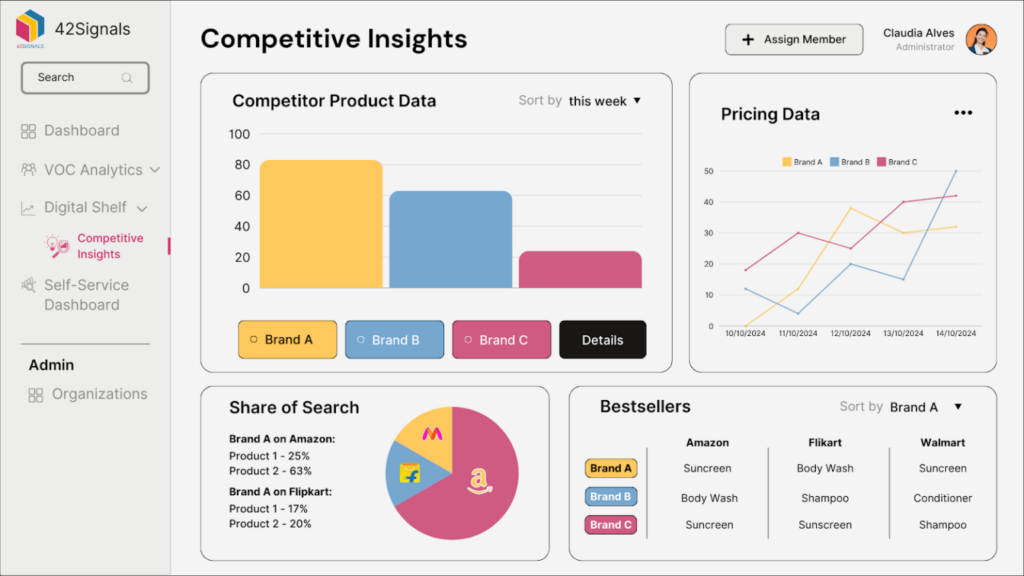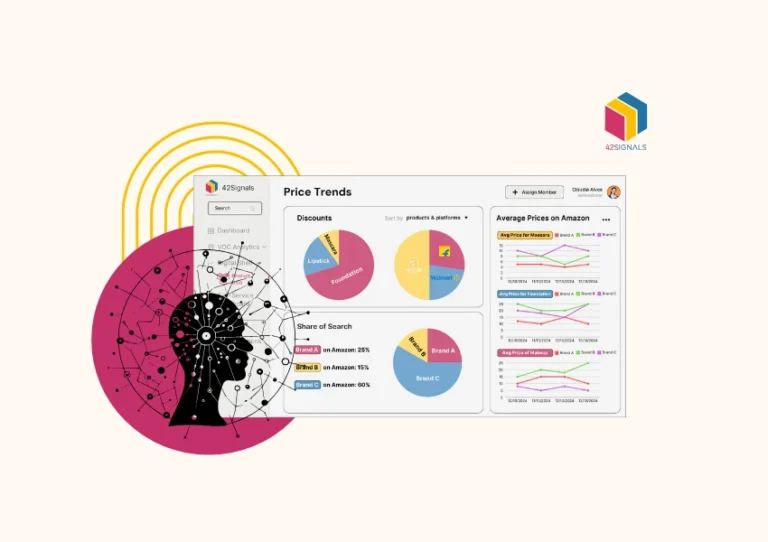With rising inflation costs showing no signs of curtailing anytime soon, businesses catering directly to consumers have begun to panic. Most retail, eCommerce, and food & beverage industries are starting to feel the stress to stay profitable, and for some, afloat. For online businesses, eCommerce competitor price monitoring can provide several advantages to learning how other brands cope with inflation and what strategies they deploy.
The Importance of ECommerce Competitor Price Monitoring

42Signals competitor analysis dashboard
Not all companies are buckling to this rising inflation pressure; Most corporate giants rely on other measures – pay cuts, workforce reductions, shrinkflation tactics, and squeezing suppliers to their limits.
For example, most of Amazon’s subsidiaries can run on a perpetual loss model as the entities are not looking to make revenue but to penetrate the market with their products and establish a loyal customer base.
In the past weeks, a staggering number of companies have announced layoffs and a hiring freeze, and the numbers are projected to climb in the upcoming months.
Smaller businesses that cannot resort to such drastic tactics, must rely on smart approaches to continue operating and generate income.
Therein lies the answer – companies must be agile and quickly adapt to these changing times by keeping a close eye on their competitors and following tactics that set them up to win.
Benchmarking & Auditing
The first step to coping with any unforeseen changes is to benchmark your company with peers and other players in the industry. Benchmarking can highlight existing gaps and show numerous areas for improvement. By understanding where the organization stands and its shortcomings, processes to boost efficiency can be implemented.

When the market is not under stress, companies can get by without lean operations as they are not competing tooth-and-nail for the customers’ attention. It’s only when the economy is under duress, that every aspect of the internal processes, expenses, inefficiencies, and wastage of resources must be looked at through a magnifying lens.
Auditing the business is the next course of action. Every retailer must know how much it costs them to make/buy their product at present. Sifting through past invoices to see the price fluctuations in materials and services is necessary to take any action.
With that data in hand, companies can decide if they can shave the costs of their product – supplies, packaging, design elements – without altering its quality or compromising on the brand’s integrity. It can be a tough call to make, but necessary depending on the direness of the situation.
Brands can also choose to stay competitive on high-demand items or bestsellers while costs can be increased on products less popular. This approach ensures that customers won’t be put off by higher costs for items they regularly purchase while the company adjusts for inflation via other goods provided.
The audit carries on to the final step of talking to customers and performing sentiment analysis. Knowing your audience and how they feel about your brand is so important, especially for small businesses. These conversations can provide a better understanding of the audience you cater to and provide decisive insights for the next steps.
eCommerce Price Analysis
Understanding the reason behind the price inflation of products is vital to compete in this market. Retailers cannot blindly accept a price change without doing their research first.
Every aspect of the product must be under scrutiny – the cost of the raw materials, manufacturing, storage, transportation, the suppliers’ cut, and the retailers’ profit margins as they all fit in the eCommerce competitor price monitoring strategy.
This data must be compared to the past year-on-year inflation to see if the price increase is reasonable.
Investing in an eCommerce price comparison tool can help gauge market prices for similar products and see variations in product details. Access to this data can prevent businesses from overvaluing or undervaluing their items which puts them at a disadvantage.
A market intelligence tool helps make sound choices rooted in facts to avoid bad decision-making that can have major repercussions.
eCommerce Competitor Pricing Strategies
Fluctuations in commodity prices with an insight tool can be easy to track. To build a well-planned pricing strategy, brands must deep dive into consumer preferences and optimize product pricing to match market practices.
By devising a competitive pricing model – incorporating price variations, promotions, and sales – based on granular data obtained from an eCommerce insight platform such as 42Signals, immediate measures can be implemented when modifications on competitors’ websites are detected.
Conclusion on ECommerce Competitor Price Monitoring

An eCommerce insight tool can anticipate consumer demand, track competition, optimize digital shelves, and grow online sales. In the current climate, retailers need any and every competitive edge they can get to keep their heads above water. When the market is flooded on the supply side, the demand side gets pickier and more selective.
Customers nowadays are spoilt for choices with an endless assortment of brands selling similar products. The biggest lasting advantage of an eCommerce company is to leverage actionable insights through digital shelf analytics that helps grow the business.
To learn more about eCommerce insights and for a demo of the 42 Signals product, please contact sales@42signals.com
Frequently Asked Questions
How to check competitor pricing?
Checking competitor pricing involves gathering and analyzing the prices your competitors charge for similar products or services. Here’s how you can do it:
- Ask Customers: Gather insights from customers who’ve compared your pricing with competitors.
- Visit Competitor Websites: Explore their pricing pages, product listings, or service menus.
- Use Price Tracking Tools: Employ software like Price2Spy, Competera, or Google Shopping to automate price tracking.
- Shop as a Customer: Engage in mystery shopping by adding items to carts or contacting sales teams to get quotes.
- Monitor Promotions: Pay attention to their discount strategies, bundles, and seasonal offers.
- Leverage Social Media and Ads: Analyze advertised pricing on social media and digital ads.
How to Conduct a Competitive Price Analysis?
Conducting a competitive price analysis helps businesses position their products effectively in the market. Here’s a step-by-step guide:
- Identify Key Competitors: Pinpoint direct competitors in your niche or market.
- Define Comparison Metrics: Focus on product features, quality, customer service, and add-ons, along with pricing.
- Collect Pricing Data: Use online research, software tools, or direct inquiries to compile competitor pricing information.
- Analyze Pricing Models: Understand whether they use cost-plus pricing, value-based pricing, or penetration pricing.
- Evaluate Market Trends: Assess industry trends, seasonal fluctuations, and economic factors influencing prices.
- Benchmark Against Your Pricing: Compare their strategies to your pricing to find gaps or opportunities.
- Take Action: Adjust your pricing strategy based on insights, ensuring it aligns with your brand value and profit margins.
How to Manage Competitive Prices?
Managing competitive prices involves maintaining a balance between staying competitive and preserving profitability. Here’s how to do it:
- Monitor Market Changes: Regularly track competitors’ prices and market trends to adjust accordingly.
- Segment Your Market: Tailor pricing strategies based on customer demographics, behavior, and willingness to pay.
- Focus on Value: Highlight unique selling points (USPs) and added benefits to justify your pricing.
- Implement Dynamic Pricing: Use real-time data and automated tools to adjust prices in response to demand and competitor activity.
- Run Promotions Strategically: Offer discounts, bundles, or loyalty programs selectively to maintain a competitive edge.
- Communicate Pricing Transparently: Build trust with customers by explaining the value behind your prices.
- Evaluate Profit Margins: Continuously review costs to ensure competitive pricing does not erode profitability.
Can You Discuss Pricing with Competitors?
In most cases, discussing pricing with competitors is prohibited under antitrust laws or competition laws. Here’s what you need to know:
- Illegal Price-Fixing: Agreements to set prices, discounts, or terms between competitors can violate laws like the Sherman Act (U.S.) or Competition Act (Canada).
- Risk of Collusion: Even informal discussions can be construed as collusion, leading to severe legal penalties.
- Industry Associations: Be cautious during industry meetings or trade association events, where pricing topics might arise.
- Exceptions: In rare cases, businesses can discuss pricing in joint ventures or partnerships, but this must comply with legal guidelines.
- Seek Legal Advice: Always consult a legal expert if you’re unsure about the legality of specific interactions with competitors.





